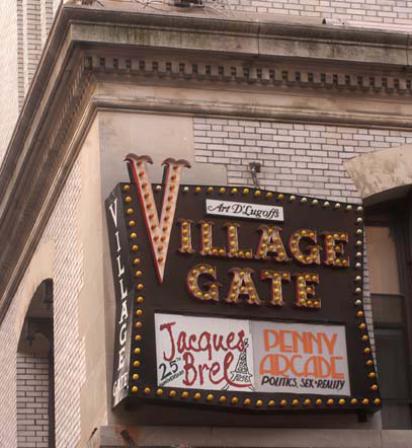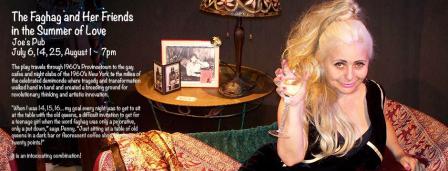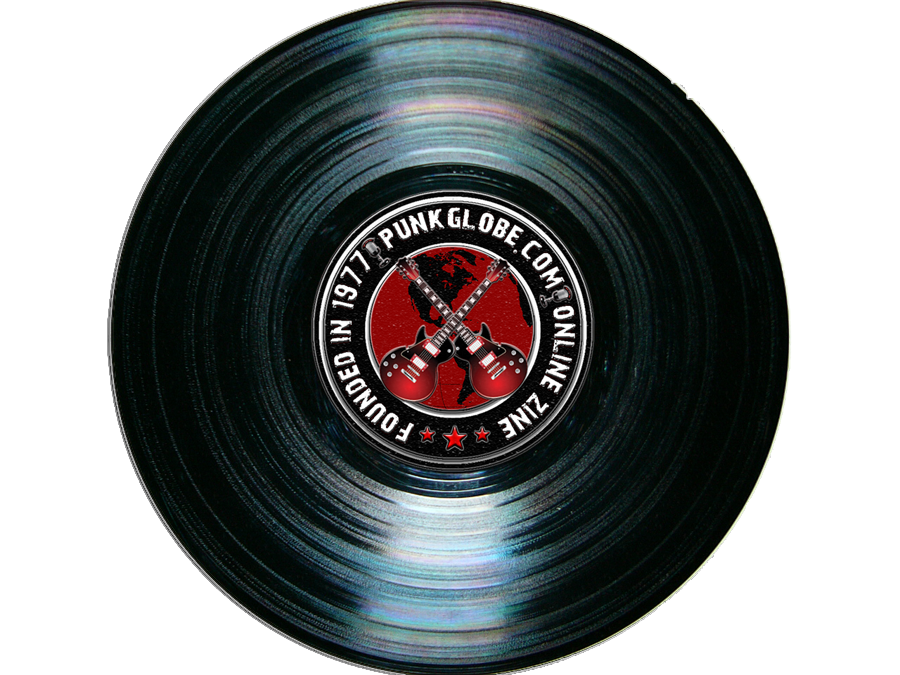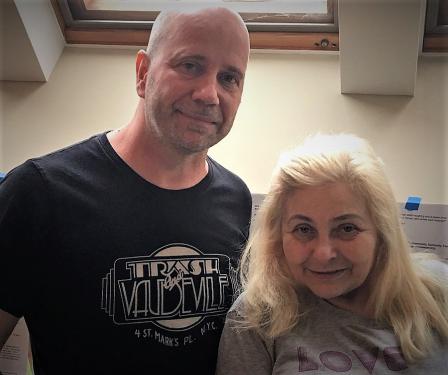Penny Arcade wears a gray T-shirt adorned with a purple Helvetica stripe that reads: Love Saves the East Village.
Dozens of sheets of white paper - each depicting a neatly typed scenario of a work-in-progress - cling to the walls around her, symmetrically fixed to the drywall with blue painters’ tape. The words float through scenarios of her teenage years, lingering over friendships forged in the gay bars of Provincetown where she sought refuge, inspiration and the courage to conquer New York City.
“The first time I came to New York, I landed right across the street from the Village Gate,” she recalls of the night her teenage self hopped a $25 shuttle out of New England, dropped acid for the first time, and touched down on the sidewalks of Bleecker Street in lower Manhattan. “It was one long bizarre night that would make a great movie,” she says.
A half-century later, Penny Arcade is the author of a dozen scripted performance plays and hundreds of performance art pieces. Her work has been produced from London to Vienna and in New York City her name is up in lights – permanently fixed to a Bleecker Street placard on the historic building that had once housed the Village Gate.
Born Susana Ventura in a small factory town in Connecticut, she named herself Penny Arcade at age 17 while living on her own in New York and where her mentor, photographer/artist Jaimie Andrews, introduced her to legendary director John Vaccaro and The Playhouse of the Ridiculous. She was subsequently recruited by Andy Warhol to be a Factory Superstar.
Fifty years later, Arcade and longtime collaborator Steve Zehentner – who sports a Trash & Vaudeville T-shirt with the original St. Marks Place address fixed to his chest – perform their work-in-progress on stage, where Arcade exhibits a magnetic aura with an ever-changing persona.
“Christopher Street, the Great Gay Rialto of my youth,” she reminisces. “The show is really about somebody who is 68 years old looking back at when they were 18.”
On stage, her characters speak of the ghosts of Christopher Street and embark on an odyssey through the East Village that touches upon everything from the Bible to AIDS to the Halloween Parade, as Zehentner provides a musical soundtrack that zags from the cheery strains of The Turtle’s “Happy Together” to that most ominous of beginnings in the Velvet Underground’s “Heroin.”
During a free afternoon between shows, Arcade and Zehentner performed as gracious hosts for a sit-down interview. This is some of what was said.

Marquee as it stands in the present day outside the former Village Gate on Bleecker Street in New York City.
Punk Globe: Your birth name is Susana Ventura. When did you become Penny Arcade?
Penny Arcade: I had the name Penny Arcade since I was 17 years old. Penny Arcade. It was supposed to be a joke. I was saving Susanna Ventura for when I did something good - unfortunately it’s taken so long that I’ve gotten stuck with Penny Arcade, haha.
Punk Globe: You worked with Andy Warhol?
Penny Arcade: He was a very complex figure. I think he was naïve about certain things, like cinema verite, which had a very big impact on the late ‘50s and early ‘60s. He thought he’d just turn on the camera. And so the films are horrible for the most part. It’s taken me years and years and years to understand Andy. You have to remember Andy Warhol did not become famous until he got shot. He was not the most important Pop Artist. He was not Claus Oldenburg, he was not seen at that level. He was seen more as a freak. And he was kind of a prankster.
Punk Globe: You bring up Warhol getting shot. Ironically, or coincidentally, it’s 50 years, nearly to the day, when Warhol was shot by Valerie Solanas.
Penny Arcade: Dead people swirl around me, I’m surrounded by dead people all the time. I carry them. I’m a portal.
Punk Globe: Is that a burden?
Penny Arcade: No, some people can handle that. I think it’s important that by the time you’re 68 years old you should have some consciousness about your own area. I’m good at that. I come from a long line of people who are very psychic, so that in-between place is not all that uncomfortable to me at all.
But Andy was a product of the 1930s and he believed he was going to become wealthy making films, because he wasn’t getting wealthy making paintings. His paintings didn’t sell well. What he was, was a very, very successful art director. They always talk about him being an illustrator, but you don’t make $200,000 a year in 1960 illustrating shoes. You’re making $200,000 in 1960 because you’re delivering campaigns. Andy’s greatest feat was convincing the art world that he was a painter, when what he actually was, was an art director. We see the results and high impact of Andy Warhol not in art, but in advertising. That’s where you can see his influence. Over time I’ve come to appreciate him as a conceptualist and kind of take his own personal quirks out of it; just him as an artist.
Punk Globe: There are vintage clips roaming in cyberspace of Penny Arcade alongside Patti Smith, Wayne County and Jackie Curtis, as well as with Holly Woodlawn and Candy Darling in the 1971 Andy Warhol film “Women In Revolt.” You worked with Patti Smith several years before she started her band?
Penny Arcade: In the early months of 1969 we became very close friends. She and I really bonded at being working-class girls in a scene of debutants. Max’s Kansas City was really diverse, but nobody was willing to talk about being working class at that point and Patti and I really bonded around that.
Patti’s an interesting person. Recently I’ve come to realize that Patti and Robert Mapplethorpe kind of heralded, in 1969, the first wave of young people where fame was more important than accomplishment. Patti wanted to be famous. First was her painting. She used to write on her paintings, which she’d show me, and they were extremely interesting.
When I met her, she had just become a poet. I look at my own poetry that I was writing in the ‘70s - I never would have shown it to anybody. But now I look at it and it’s like: Oh, it’s not that bad. But, you know, I had to get Patti Smith’s voice out of my head. Literally: Her Voice, because Patti talked like: “Hey man, wanna see what you writ…” And because I’m a mime I always sound like whoever I’m with. She was imitating Dylan and I was imitating her, haha. I was in the first play she was in, “Femme Fatale.” We had a joke at Max’s one night which went on for several weeks that Patti and I were going to start a band. I mean, there was something that was transferred between the two of us. Patti was just much shrewder than I was.
Punk Globe: You also worked with Jayne County back in the Wayne County days?
Penny Arcade: Jayne County to me is the most important person in the punk scene and way more important than Patti, Richard Hell or any of them – really an intrinsic rock ‘n’ roller. You know we believed that Dylan and the Rolling Stones were talking directly to us. That was our religion. Rock and roll was our religion, and Jayne County was the person who took it to heart. What else can a poor boy do, except play in a rock and roll band? Jayne was naturally predisposed to be a rock and roll star. A real student of rock and roll, a fey, transgender, very-fragile-kind-of-creature, but she cut out her own turf for herself. When you see those early images – showing up in drag with the Dave Clark 5 in her hair…
Punk Globe: You left for Europe in the early ‘70s.
Penny Arcade: I went to Europe in ’71 with Vaccaro and I didn’t come back til ’75. And then I didn’t stay in New York, I went to Maine and lived in the woods. At that point – when I left in ’71, that’s when people started putting bands together. David Johansen tried doing theater. He worked with Charles Ludlum in a couple of plays, but then he decided to do a band (New York Dolls).
I was working with Andy Warhol and I was supposed to be in this play that was written based on tapes. Andy taped all his phone conversations. Tony Ingrassia, who I had worked with, made a play out of these phone tapes. That was ‘Pork.’ But I decided to go to Amsterdam (instead) with John Vaccaro because I was underwhelmed by the whole Warhol experience. They went to London and Tony Zanetti ended up meeting Tony Defries, who was managing David Bowie. Bowie was this boring kind of folk singer. They brought the Playhouse of the Ridiculous glitter-glam thing to David Bowie and started dressing David like Angela Bowie. The rest is history.
I was thinking about making my own work and the first thing I wanted to do was to become other people. I thought this would be a very interesting thing to do. I was always good at mimicry - like Andrea ‘Whips” – who was a Warhol Superstar – I used to imitate her. The reason I didn’t do “Pork” was I wanted to play my role as Andrea Whips. And Tony Ingrassia who was directing it was like, “Are you kidding me? Isn’t it bad enough we have to deal with Andrea every night at Max’s? You want to put her on stage?” So, I went to Amsterdam.
You have to remember there was no audience. The audience was each other. The only time you have a real arts scene is when there’s no audience; when people are making work that’s coming directly out of themselves and their audience is the people who are doing the same thing. It’s not like you’re going out into… you know. None of these people were doing it with any hope of making money.
Punk Globe: John Vaccaro and The Playhouse of the Ridiculous was a huge influence on you.
Penny Arcade: Vaccaro’s work is still not understood. I am his protegee. All the elements in my work come from the Playhouse of the Ridiculous, except I do costumes. Vaccaro’s work was political. He wasn’t interested in Man’s struggle against Man; he was interested in society.
Charles Ludlum was an accolade of Vaccaro. He left the Playhouse when I came. I only did one play with Charles. The difference between the Playhouse of the Ridiculous and the Theater of the Ridiculous – which is Charles’ company – was the difference between the Beatles and the Rolling Stones. Vaccaro was like the Rolling Stones.
Punk Globe: Downtown New York during the late ‘60s was a creative as well as a volatile time.
Penny Arcade: I’m part of the original youth culture in the ‘60s. The Lower East Side was really grim at that time. I was an at-risk teenager like many, many teenagers who were there. You know people talk about the East Village in the sixties, but they don’t talk about how it also attracted tons of predators. While there was a lot of low energy in the sixties, there was also a lot of high-mindedness. I mean look at the people who were leading the sixties for young people: Paul Krassner, Abbie Hoffman, Lenny Bruce, James Baldwin. I come from an era when James Baldwin was on television. Gore Vidal was on television. Maybe if you were a bright kid, you were tuned in to these kinds of things. Regardless of what brightness you had, the mentality that was being driven was that of a seeker. You talked about how you were going to change things – all that slang of that period showed how there was a lot of thinking: introducing the idea of karma, the idea that you could become a more evolved person.
I think we all glom onto whatever resonates with us personally on a spiritual level, on a metaphysical level. We come here with purpose. I believe that we are born with purpose. That we all have certain lessons we are here to learn. That’s the purpose of life: for evolution. And it’s not a complete evolution. Whatever my standards are of who I think I should be, I’m not attaining them in this lifetime, you know? I think evolution continues.
Punk Globe: In 1999, Penny Arcade and Steve Zehentner created The Lower East Side Biography Project - a biography series and oral history archive which includes recorded interviews with, among others, Fugs’ co-founder Tuli Kupferberg, Leee Black Childers, Holly Woodlawn and Jayne County. They may be viewed at: http://stevezehentner.com/lower-east-side-biography-project. Penny Arcade continues to perform in a variety of her performance plays, performance art pieces and works-in-progress, across the country. For more information, go to: http://pennyarcade.tv/.

Poster advert promoting Penny Arcade’s recent show, “The Faghag and Her Friends in the Summer of Love”



